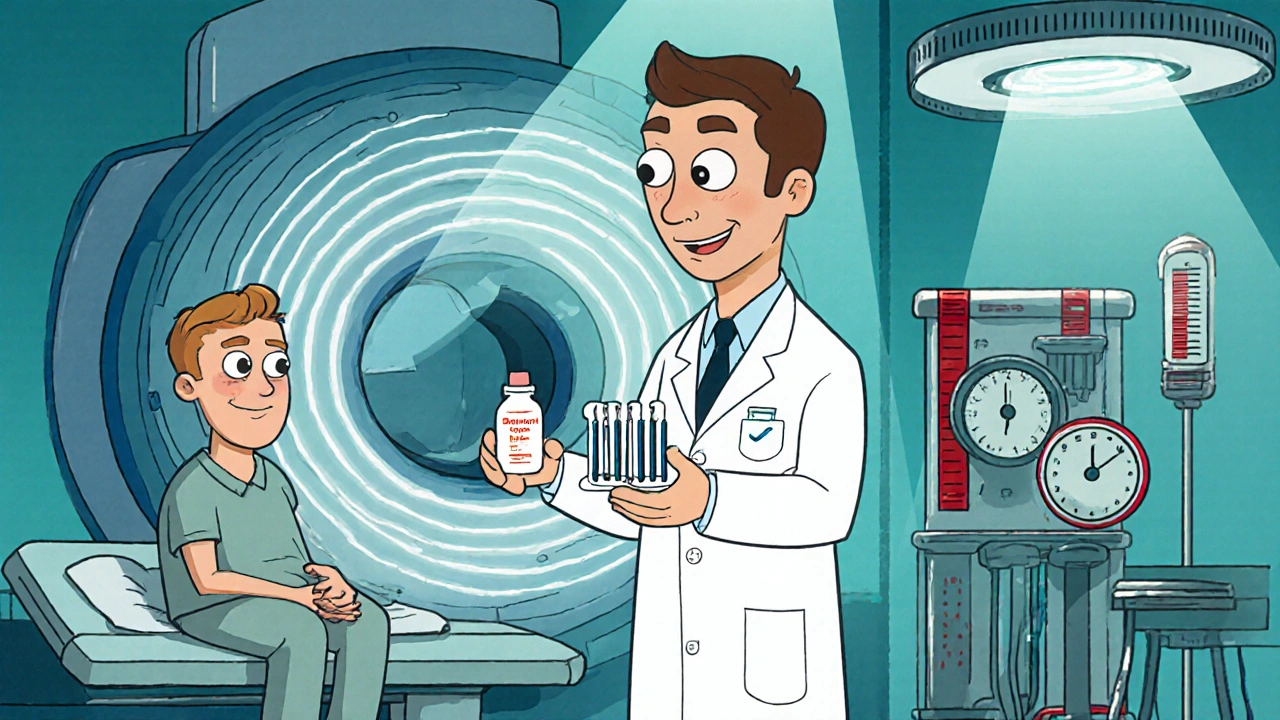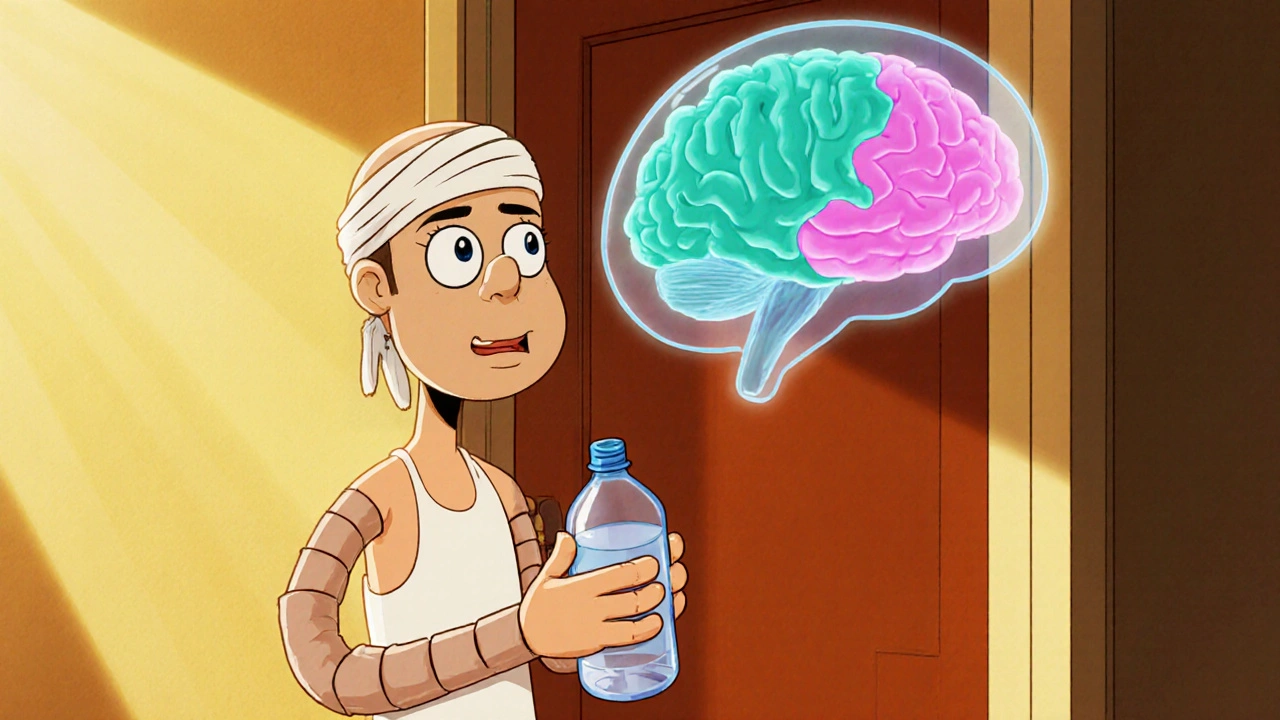NDI/SIADH Symptom Checker
Symptom Assessment Tool
This tool helps identify if you may be experiencing Neurogenic Diabetes Insipidus (NDI) or Syndrome of Inappropriate ADH (SIADH) after head trauma.
Your Results
Experiencing increased urination after head trauma can feel like a mystery that suddenly shows up in the middle of recovery. It’s not just a nuisance - it can signal serious disruption of the brain’s water‑balance system. This guide walks you through why it happens, how doctors figure it out, and what you can do to get back on track.
Why the Brain Controls Urination
The brain regulates water balance through a tight feedback loop. When blood osmolarity rises, the hypothalamus detects the change and signals the posterior pituitary to release antidiuretic hormone (ADH). ADH travels to the kidneys and tells them to re‑absorb water, shrinking urine output. Damage to any part of this loop can flip the switch, causing either too much or too little urine.
Key Brain Structures Involved
- Antidiuretic hormone (ADH) also called vasopressin, the hormone that tells kidneys to retain water
- Pituitary gland stores and releases ADH under hypothalamic direction
- Traumatic brain injury (TBI) any external force that disrupts normal brain function, often classified as mild, moderate, or severe
- Micturition reflex the neural circuit that coordinates bladder filling and emptying, involving the pontine micturition center
Two Main Hormonal Scenarios
When the brain’s water‑balance system goes awry after trauma, two opposite hormonal disorders can appear:
| Feature | Neurogenic Diabetes Insipidus (NDI) | Syndrome of Inappropriate ADH (SIADH) |
|---|---|---|
| ADH level | Low or absent | Elevated |
| Urine volume | >3 L/day (dilute) | Reduced |
| Serum sodium | Low‑normal or high | Hyponatremia |
| Typical cause after head trauma | Damage to hypothalamus or posterior pituitary | Disruption of hypothalamic regulation leading to excess ADH |
| First‑line treatment | Desmopressin (DDAVP) or fluid replacement | Fluid restriction, sometimes demeclocycline |
Both conditions can show up after a severe blow to the head, but the symptoms point opposite ways. NDI drives the “too much pee” problem, while SIADH leads to water retention and low sodium.
Neurogenic Diabetes Insipidus - The Most Common Cause of Excess Urine
Neurogenic diabetes insipidus (NDI) is a disorder where the brain cannot produce or release enough antidiuretic hormone, causing the kidneys to dump large amounts of dilute urine. It can appear within days of surgery that manipulates the pituitary, or weeks after a concussion that bruises the hypothalamus.
Typical signs include:
- Frequent trips to the bathroom (often >8 times a day)
- Cold, pale skin due to fluid loss
- Thirst that feels unquenchable (polydipsia)
- Low urine specific gravity (<1.005)
Because dehydration sets in fast, patients may develop dizziness, tachycardia, or even fainting.

Other Reasons for Increased Urination After Head Injury
- Bladder dysfunction damage to the spinal tracts that control sphincter coordination, leading to overactive bladder
- Medications such as diuretics or osmotic agents used to control cerebral edema
- Electrolyte shifts (e.g., hypercalcemia) that increase kidney filtration
- Infections like urinary tract infection that develop during hospital stay
Sorting out which factor is dominant requires a systematic work‑up.
Diagnostic Work‑up: From Bedside to Lab
Doctors follow a stepwise approach:
- History and physical. Timing of urine change, fluid intake, medication list, and severity of head injury are recorded.
- Urine studies. Specific gravity, osmolality, and electrolytes are measured. Dilute urine (<300 mOsm/kg) points toward NDI.
- Serum labs. Sodium, osmolality, and ADH levels (if available) are checked. Low ADH favors NDI; high ADH suggests SIADH.
- Water deprivation test. Under close monitoring, fluids are withheld to see if urine concentrates. In NDI, urine remains dilute despite rising serum osmolality.
- Imaging. MRI of the sellar region reveals pituitary stalk injury, hemorrhage, or surgical changes.
Because the water‑deprivation test can be risky after a brain injury, many clinicians opt for a rapid desmopressin trial: a single dose of DDAVP should raise urine osmolarity within an hour if NDI is present.
Treatment Strategies
Therapy targets two goals: stop dehydration and, when possible, replace the missing hormone.
- Desmopressin (DDAVP). A synthetic ADH analog given as a nasal spray, tablet, or injection. Starting dose is usually 0.1 µg intranasal twice daily, titrated to keep urine output under 2 L/day.
- Fluid management. Replace losses with hypotonic fluids (e.g., 0.45% saline) while monitoring serum sodium to avoid rapid shifts that could cause cerebral edema.
- Electrolyte vigilance. Sodium, potassium, and calcium are checked every 4-6 hours in the acute phase.
- Address underlying cause. If surgery caused the pituitary injury, endocrinology follow‑up may involve hormone replacement beyond ADH.
- Supportive care. Encourage small frequent sips rather than large boluses; use bladder training if overactive bladder persists.
Most patients stabilize within a week, but some need long‑term desmopressin for months or years.
When to Call a Doctor Immediately
Even if you’ve been told the urine change is expected, certain red flags demand urgent attention:
- Sudden drop in blood pressure or heart rate
- Severe headache, confusion, or loss of consciousness
- Persistent fever (>38 °C) indicating infection
- Urine output exceeding 5 L in 24 hours
- Rapid rise in serum sodium above 150 mmol/L (risk of brain shrinkage)
These signs may signal worsening hormonal imbalance, bleeding, or infection - all of which need prompt medical care.
Long‑Term Outlook and Lifestyle Tips
Most people regain normal bladder habits once the hormone balance is restored, but a few tips help keep things steady:
- Track fluid intake and urine output in a notebook or app for the first month.
- Avoid caffeine and alcohol, which can aggravate polyuria.
- Maintain a balanced diet rich in fruits and vegetables to keep electrolytes stable.
- Schedule regular follow‑ups with an endocrinologist; blood tests every 3-6 months are typical.
- If you’re on desmopressin, never double the dose on your own - it can cause water retention and hyponatremia.
With proper monitoring, most patients return to normal activities within a few weeks.
Frequently Asked Questions
What causes increased urination after a head injury?
The most common cause is neurogenic diabetes insipidus, where damage to the hypothalamus or pituitary blocks antidiuretic hormone release. Other contributors include bladder‑control nerve damage, medication side‑effects, electrolyte shifts, or infections.
How is neurogenic diabetes insipidus diagnosed?
Doctors start with urine and serum osmolality tests, then may perform a water‑deprivation test or a rapid desmopressin trial. MRI of the sellar region helps locate structural damage.
What treatments are available?
The cornerstone is desmopressin, a synthetic ADH analog, combined with careful fluid and electrolyte management. Underlying injuries may need neurosurgical or endocrine follow‑up.
When should I seek emergency care?
Call 911 or go to the ER if you notice a sudden drop in blood pressure, severe confusion, urine output over 5 L/24 h, or a rapid rise in serum sodium above 150 mmol/L.
Can the problem resolve on its own?
Mild cases may improve as swelling recedes, but most patients need medication to replace the missing hormone. Ongoing follow‑up is essential to avoid chronic dehydration.

Shubhi Sahni
October 23, 2025 AT 18:32Understanding the hypothalamic‑pituitary axis after a head injury, dear friends, is crucial; you’ll notice that the pituitary may become disconnected, leading to either a surplus or a deficit of ADH, and that, in turn, directly influences urine output, so keeping an eye on serum sodium and urine osmolality becomes indispensable; remember to hydrate responsibly, but not excessively, and to report any sudden spikes in bathroom trips to your neurologist, as early detection can prevent complications, and don’t forget that support groups can provide emotional reinforcement during recovery, too.
Danielle St. Marie
October 26, 2025 AT 02:06Frankly, only those who have truly mastered neuroendocrinology can appreciate the subtle dance between the posterior pituitary and the kidneys-something our American medical schools excel at, unlike many overseas institutions 🙄🇺🇸. If you’re still confused, perhaps you should revisit the basics and stop relying on vague internet articles. 💡📚
keerthi yeligay
October 28, 2025 AT 09:39Drink plenty water, but watch for polydipsy signs.
Jinny Shin
October 30, 2025 AT 17:12The shadows of trauma linger, whispering of lost balance; yet we stand, poised, awaiting the tide of equilibrium to return, a silent drama etched upon the cerebrum.
Mike Peuerböck
November 2, 2025 AT 00:46The phenomenon of increased voiding following cranial insult warrants meticulous clinical scrutiny.
First, the clinician must ascertain whether the patient exhibits signs of neurogenic diabetes insipidus or the opposite syndrome of inappropriate antidiuretic hormone secretion.
In the former scenario the hypothalamic nuclei responsible for vasopressin synthesis have suffered direct injury or disruption.
Consequently the posterior pituitary releases insufficient hormone and the kidneys excrete copious dilute urine.
Patients will present with polyuria polydipsia and often a low specific gravity on urinalysis.
In contrast the latter condition reflects an excess release of vasopressin despite normal plasma osmolality.
This leads to water retention hyponatremia and a reduced urine output.
Distinguishing between these entities relies on careful measurement of serum sodium osmolality and urine osmolarity.
Magnetic resonance imaging may reveal lesions in the hypothalamic or pituitary region that corroborate the biochemical findings.
Therapeutically neurogenic diabetes insipidus responds well to desmopressin a synthetic analog of vasopressin administered intranasally or orally.
Fluid replacement strategies must also be tailored to avoid dehydration.
In cases of syndrome of inappropriate antidiuretic hormone fluid restriction remains the cornerstone of management.
Occasionally pharmacologic agents such as demeclocycline are employed when restriction alone fails.
The multidisciplinary team consisting of neurologists nephrologists and endocrinologists should coordinate care to monitor electrolytes closely.
Patients and families should be educated about the signs of rapid sodium shifts which can precipitate seizures or cerebral edema.
Ultimately timely diagnosis and appropriate hormone modulation restore homeostasis and improve functional outcomes.
Simon Waters
November 4, 2025 AT 08:19Some think the guidelines are just a way for pharma to push more drugs we don’t really need.
Vikas Kumar
November 6, 2025 AT 15:52Our healthcare system should never have to borrow ideas from foreign labs it’s time we trusted our own doctors.
Celeste Flynn
November 8, 2025 AT 23:26When evaluating post‑traumatic polyuria start with a basic serum sodium check then move on to a water deprivation test if diabetes insipidus is suspected it’s a systematic approach that saves time.
Shan Reddy
November 11, 2025 AT 06:59Got it man, I’ll run the labs tomorrow and keep an eye on the urine output.
CASEY PERRY
November 13, 2025 AT 14:32In the context of neuroendocrine disruption the differential diagnosis should prioritize central diabetes insipidus versus SIADH based on osmolar parameters.
Naomi Shimberg
November 15, 2025 AT 22:06While the prevailing consensus emphasizes hormonal imbalance as the primary culprit, one must also consider alternative etiologies such as occult infections or iatrogenic influences that are often dismissed.
kenny lastimosa
November 18, 2025 AT 05:39Indeed the mind‑body interplay is far more intricate than a single hormone cascade can capture, reminding us that humility remains essential in clinical reasoning.